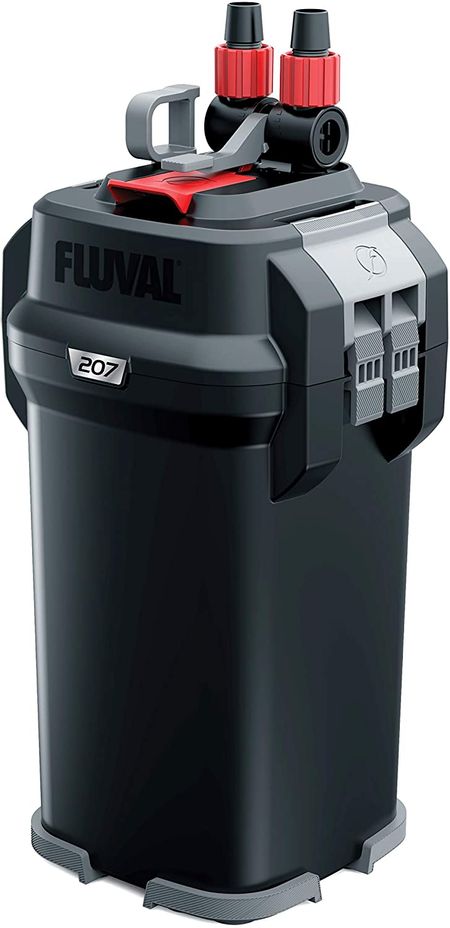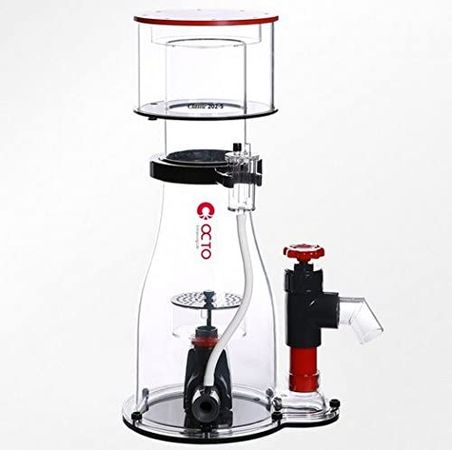Saltwater Aquarium Filter Options
Before you jump in and start buying equipment to filter your aquarium, make sure you understand the different processes involved in filtering a saltwater aquarium.
It's possible that when you purchase your aquarium it will come with filtration equipment included. If not, it will likely include some sort of compartment or attachment point to use for filtration. You can't really filter your water too much, but you can definitely waste your money by buying too much equipment that isn't actually helping you.
Keep in mind that the live rock in the tank is always the core of the biological filter since that's where a majority of the bacteria lives. The porousness of the rock provides a high surface area for the bacteria to grow.
Below are the most common types and styles of saltwater filters that are oftentimes used in conjunction with each other.
Hang On Back Filters

Benefits
- All in one, self-contained unit
- Cheap and easy for beginners to understand and maintain
- Most provide both biological and mechanical filtration
Drawbacks
- Generally include chemical filtration which you likely don't need
- No real room for adding more media
- Big and bulky hanging off the side of your tank
- Geared more towards freshwater aquariums
Most people are familiar with the hang on back (HOB) style filters. If you had a freshwater fish tank as a kid, this is likely the type of filter that it had. This style of filter sits on the top rim of your aquarium and sucks water through it, running it over some type of filter cartridge before shooting it back out into the tank. Most models also run the water over some type of "bio media" which is used to grow out your biological filtration.
The cartridges that these filters use are generally plastic cages with filter floss on the front water facing side and granular activated carbon inside. The filter floss acts as a mechanical filter, straining larger solids like food and fish waste out of the water. The carbon inside the cartridge acts as a chemical filter which, again, is likely not needed in a healthy tank.
These units tend to be relatively large since they have to contain the filter media itself, some type of bio media (bio balls and ceramic rings being the most common), and the pump to pull the water through the unit. They're generally mounted on the back of the aquarium, so you'll have to make sure that you have enough space between the tank itself and the wall behind it.
General maintenance on a hang-on-back filter will mostly just require you to replace the filter cartridges. You'll buy packs of them and, every week or two, just pop the old one out and stick the new one in. If your filter has multiple slots then it's a good idea to leave the old one in for a few days along with the new one and then throw it away. This allows the old cartridge to 'seed' the new cartridge with bacteria that will help your filtration.
This style of filter does definitely work in a saltwater tank, but it's not generally going to be the most effective approach. If you have a large tank, then a HOB filter is likely not a good candidate at all. Hang on back filters are generally best suited for smaller or entry-level tanks where you want to avoid any large upfront investments.
Canister Filters

Benefits
- All in one, self-contained unit
- Can be used in conjunction with other filtration types
- Provides multiple layers of filtration
- Hidden underneath the tank
Drawbacks
- Can be annoyingly difficult to clean
- Large and bulky
- Water rate slows significantly as waste builds up
Canister Filters are similar to hang-on-back filters except they exist outside your aquarium - generally being hidden underneath it. A pump in the canister filter pumps water out of your tank and through the filter, returning it back into your tank through a separate tube. Depending on your setup, the canister filter may also pump the water into a sump rather than directly back into your tank.
Inside a canister filter there are generally multiple layers of filter media. What, exactly, each layer is made up if is going to be up to you, but most hobbyists can safely just follow these general guidelines:
- Some type of mechanical filtration - filter floss or a filter pad, generally - is always going to be the first layer that the water hits in the canister filter. If you read through the filtering a saltwater aquarium article then you likely remember that the mechanical filtration layer is used to remove solids like extra food and fish waste from the water. The manufacturer of your canister filter will likely sell pre-cut mechanical filter pads that you can just drop right in.
- A chemical filtration layer - activated carbon, generally - will often times come next. Keep in mind that in the vast majority of instances, activated carbon is not actually doing anything in your tank. There are exceptions to this rule (removing certain medications from the tank, for example) but in general, you don't need it. It generally doesn't hurt to include it and will definitely help to remove any odors that you might be smelling, but in general you can safely omit it.
- Finally, there should be ample room for biological filtration media. There are a few different mediums that are a good fit for biological filtration in a canister filter but the ones you'll see most commonly are Bio Balls and pieces of ceramic. The point of these is to provide a high level of surface area for the good nitrifying bacteria to grow on. Once you put these in, you should essentially never replace them. If you do, you'll be throwing away all of your good bacteria.
One drawback to a canister filter is that you do have to take it apart to replace your mechanical filtration (the filter floss or pads that exist as the first layer). This is going to be messy at times since the canister is a self-contained unit. You'll always want to clean the canister itself. Over time, your water flow is going to be reduced due to build up within the canister itself. It's important to keep it clean so that your filter continues to operate at a high capacity.
Canister filters are great for small to medium-sized saltwater aquariums as long as you remember to regularly replace the mechanical filtration media. When looking for one, pay particular attention to the number of gallons per hour that it can filter and shoot for 5-10x the gallons of water in your tank. Also consider using a canister filter in conjunction with other filtration types like protein skimmers.
Protein Skimmers

Benefits
- Highly effective at removing solids
- Very little maintenance required
- Can be hidden in the sump if you have one
Drawbacks
- Sometimes noisy
- Requires tuning to get peak performance
- The great ones are pretty expensive
Protein skimmers are a more advanced type of filtration used to remove organic compounds, such as fish waste and uneaten food, before they have a chance to break down and turn into harmful ammonia or nitrate. The process of removing these organic compounds is called protein skimming.
Protein skimmers work by creating a column of air and water, which causes organic molecules to attach to the surface of the air bubbles. These bubbles then rise to the top of the column and spill over into a collection cup where the organic compounds are collected and removed from the aquarium. What ends up in the cup is called skimmate. The resulting water that is returned to the aquarium is cleaner and clearer, which helps maintain a healthy environment for fish and other aquatic life.
Most protein skimmers require a break-in period before they start working efficiently, so it's important to allow time for the equipment to settle in before expecting optimal performance. Once the skimmer is running, it's important to keep an eye on it to ensure that it's collecting all the organic compounds that it's supposed to. If the collection cup on the skimmer is getting full, you'll need to empty it out to keep the skimmer working properly.
To take care of a protein skimmer, you'll want to keep it clean and free of buildup. You can do this by rinsing it out with fresh water every once in a while. It's also important to make sure that the skimmer is getting enough air, so you'll want to check the air intake valve to make sure it's not clogged. Finally, if you notice that the skimmer isn't working as well as it used to, it might be time to replace the air stone or pump.
Protein skimmers come in sizes that will work with any aquarium - large or small. They are, generally speaking, the most expensive piece of filtration equipment that you'll find but also the most effective at removing waste before it begins to break down.

